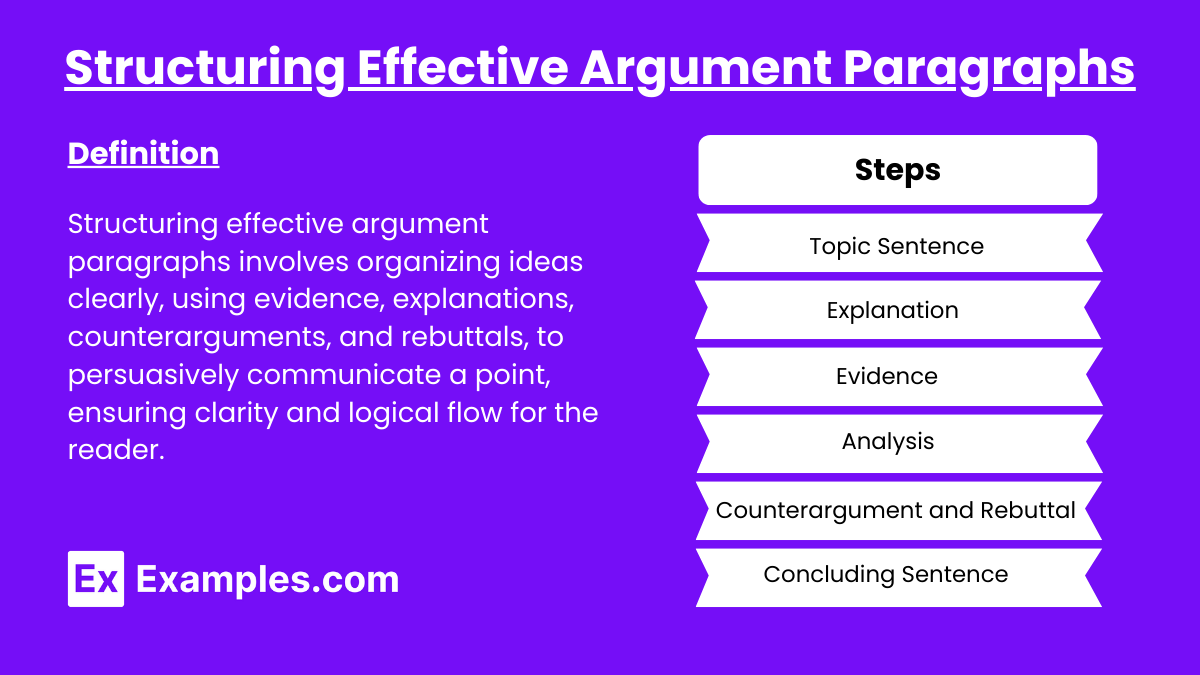Constructing effective argument paragraphs is essential for crafting persuasive and coherent essays in AP English Language and Composition. Each paragraph must not only present a clear and focused claim but also support it with relevant evidence and thorough analysis. By mastering the structure of argument paragraphs, students can enhance their ability to present logical and compelling arguments, address counterarguments thoughtfully, and ensure a smooth flow of ideas throughout their essays. This guide will outline the key components of an effective argument paragraph, providing a step-by-step approach to help students develop their writing skills and articulate their arguments with clarity and precision.
Free AP English Language and Composition Practice Test
Steps to Structuring Effective Argument Paragraphs
1. Topic Sentence
Purpose: Introduce the main idea of the paragraph.
Action: State your argument or main point clearly and concisely.
Example: "Implementing renewable energy sources is essential to combat climate change."
2. Explanation
Purpose: Elaborate on the topic sentence and provide necessary context.
Action: Explain the importance or relevance of the topic sentence.
Example: "Renewable energy sources like solar and wind power produce no greenhouse gas emissions during operation, unlike fossil fuels."
3. Evidence
Purpose: Support the topic sentence with facts, statistics, examples, or quotes.
Action: Provide specific and credible evidence to back up your argument.
Example: "According to a 2022 report by the International Energy Agency, renewable energy accounted for 29% of global electricity generation, significantly reducing carbon emissions."
4. Analysis
Purpose: Interpret the evidence and show how it supports the argument.
Action: Explain the significance of the evidence and connect it to your main point.
Example: "This data indicates that as more countries adopt renewable energy, there is a measurable decrease in global carbon emissions, demonstrating the effectiveness of these technologies."
5. Counterargument and Rebuttal (Optional)
Purpose: Address potential objections to your argument and refute them.
Action: Present a counterargument and then explain why it is not valid or less important.
Example: "Some argue that renewable energy is too expensive to implement widely. However, the cost of solar panels and wind turbines has decreased by over 80% in the past decade, making them more affordable and accessible."
6. Concluding Sentence
Purpose: Summarize the paragraph and reinforce the main point.
Action: Restate the main idea and lead into the next paragraph or conclusion.
Example: "Therefore, investing in renewable energy is both an effective and economically viable strategy to address climate change.
Example for Structuring Effective Argument Paragraphs
Topic Sentence: The implementation of stricter gun control laws is necessary to reduce gun violence in the United States.
Evidence: A study conducted by the Centers for Disease Control and Prevention (CDC) in 2021 found that states with more restrictive gun laws have 25% fewer gun-related deaths than states with more lenient laws.
Explanation: This data indicates that stricter gun laws can lead to a significant decrease in gun violence, which is a major public health issue in the country.
Counterargument: Opponents of stricter gun control laws argue that such measures infringe on Second Amendment rights and that responsible gun owners should not be penalized for the actions of criminals.
Rebuttal: However, the primary aim of gun control laws is not to infringe on individual rights but to ensure public safety. Moreover, countries with stringent gun control laws, such as Australia and the UK, have successfully reduced gun violence without completely banning gun ownership.
Concluding Sentence: Therefore, the enactment of stricter gun control laws is a critical step toward creating a safer society, balancing the right to bear arms with the need to protect citizens from gun violence.


